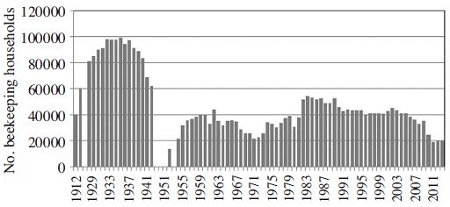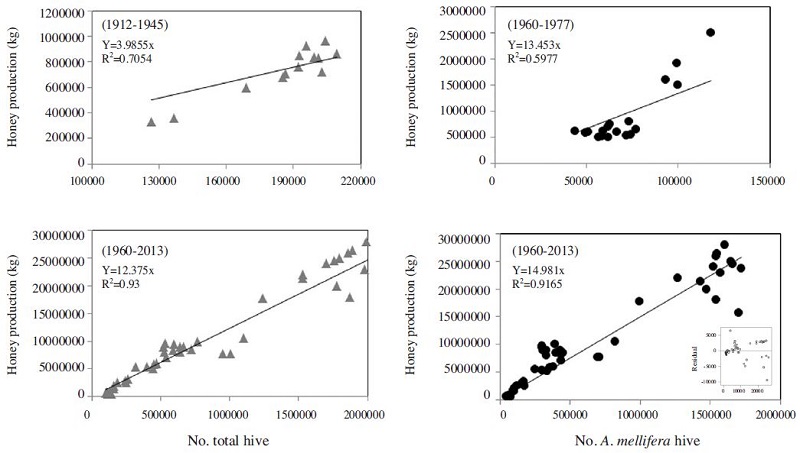
Relationship Between Honeybee Population and Honey Production in Korea: A Historical Trend Analysis
Abstract
The honey bee provides various ecosystem service as well as direct income source of beekeeping industry. The primary product from beekeeping is the honey which is defined as “the natural sweet substance produced by honey bees from the nectar of plants, which the bees collect, transform by combining with specific substances of their own, deposit, dehydrate, store and leave in the honey comb to ripen and mature” In Korea, two species of honey bees are kept by beekeepers; Apis cerana and A. mellifera. There were four historical patterns of bee population found; phase I, A. cerana dominated but total hive numbers below 200,000 until 1950s, phase II, both species low below 500,000 until 1977, phase III, both species increasing with A. mellifera dominant until saturation of two million hives near 2005, and phase IV, A. mellifera dominating but A. cerana declining in 2010s. Patterns of national honey production were reflected by the hive population reaching 28,000 tons in 2009. Honey production per hive was 4kg in phase I, and 12.4kg during phase II-IV. If the numbers of A. mellifera colonies were considered, the productivity was 15kg per hive. Residual variation was higher in the recent years implying some other factors such as honey plant biology, pest and disease pressure could influence the honey yield which can be further studied.
Keywords:
Apis cerana, Apis mellifera, Honey production, Productivity, Colony declineINTRODUCTION
Korea has a long history of beekeeping dating back to the early written history of Great King Dongmyeongsung of Goguryeo between BC 37-19 (Lew, 1988a, 1991; Jung, 2014). Two species of honeybee are kept in Korea. Apis cerana (Native honey bee = tobong or jaerae-ggulbeol) is usually kept in deep in the mountains while exotic species of A. mellifera (European honey bee) was believed to be introduced in early 1900s (Jung, 2014) and is usually kept in the outskirt of the mountainous regions including agricultural area. The native bees are kept in the log or smaller box system while the European honeybees are mostly housed in the standard Langstroth hive.
The honey bee provides various ecosystem services including pollination of agricultural crops as well as direct income sources of beekeeping industry such as honey, wax, pollen, propolis, and bee venom. The primary product from beekeeping is the honey which is defined as “the natural sweet substance produced by honey bees from the nectar of plants, which the bees collect, transform by combining with specific substances of their own, deposit, dehydrate, store and leave in the honey comb to ripen and mature”
In the global scale, honey production approximated 1.54 million tonnes in 2010 which was 10% increase from 1.4 million tonnes in 2005 (FAOstat). From the previous publication of Korean beekeeping status and comparison of national honey production of some important beekeeping countries based on FAOstat (Lee et al., 2010), national honey production showed positively trend with the number of colony, but with large variation. Many factors affect the yield of honey production. Distribution of honey flora, and intensity and longevity of honey flows can be the first importance (Farrar, 1937). Population characteristics of honeybee itself, pest and disease management, beekeeping practice, as well as the weather conditions also affect. Among those, number of bee colony would directly influence to the total honey production in the nationwide. In Korea, number of bee hive approximates 2,000,000 and honey production ranges between 20,000 and 27,000 tons recently (Lee et al., 2010; Jung, 2014). There have been several reports on the beekeeping statistics of Korea but most of them are incompletely cover the whole range of modern beekeeping era from early 1900s up to now. In this paper, we tried to collect honey bee population data and honey production data from early 1900s and analyzed the pattern of honey population growth of two species and relationship of honey production.
MATERIALS AND METHODS
Beekeeping statistics of number of colony of each species, number of beekeeping household, honey production were based on the animal statistics of Ministry of Agriculture, Korean apicultural association, and Korean beekeeping cooperatives. Data before 1945 could cover the whole Korean peninsula (KBA, 1983). These data were from the But data after 1950s cover only the statistics of southern part of Korean peninsula, Republic of Korea. Honeybee colony numbers and honey production data were compared with FAO statistics (http://faostat.fao.org/), Kim and Jung (2007) and Lee et al. (2010), and missing values or outliers were modified relevantly. Most data cover from 1912 to 2013 with some period blanks because of the insufficiency for data collection.
Relationship between the number of hives of each species of honey bee and honey production was analyzed by regression using SAS 9.4 (SAS, 2013) with explanatory variables as number of colony of A. cerana, A. mellifera or both species with P<0.05 level. The analysis was separated into 4 phase of beekeeping industry development in Korea as described below.
RESULTS AND DISCUSSION
Number of beekeeping householder trend
There are three prominent trends found from the beekeeping householders data that from the beginning of the modern beekeeping from 1910s (Fig. 1), number of beekeeping householders dramatically increased up to 100 thousands until 1945, and after then it was maintained around 40 thousands for over fifty years until early 2000s. But after 2003, the number of beekeeping householders constantly decreased to 2013. Most of the beekeepers in 1910-1930s would had possessed only a few colonies, but the rapid increase of the number reflects the need of good carbohydrate sources of sweet or medicinal purpose with premium price meaning higher reward over the relatively lower investigation (Jung, 2014). At that time, sugar became popular but expensive items for refreshment for the higher class citizen (Lew, 1988b; Lee, 2012). During late 1960s and mid-1970s, significant decline of the beekeepers would be partly attributed to the socioeconomic condition of huge demands of labors in the city for civil and economic development in Korea, so called migration from rural to urban (Kim and Topel, 1995).
Hive population trend
Combined analysis of Fig. 2 and Fig. 3 revealed that there are 4 distinct phases of beekeeping development in Korea; phase I, A. cerana dominated but total hive numbers below 200,000 until 1950s, phase II, both species low below 500,000 until 1977, phase III, both species increasing with A. mellifera dominant until saturation of 2,000,000 near 2005, and phase IV, A. mellifera dominating but A. cerana declining in 2010s. During the phase I, honey bee hive population gradually increased from 100 thousands to 200 thousands, and then decreased again to lower than 100 thousands in early 1950. During that end of time was the political instability with questionable data recording. Apis mellifera is considered to be introduced from the Western in early of 1900s (Lew, 1988a, 1991; Jung, 2014). The phase I was dominated by A. cerana accounting more than 80% of total hives. Phase II is the static period of beekeeping industry with relatively lower beekeeping activities in terms of hive population after the Korean War (1950-1953). In 1954, total hive numbers were only 50 thousands with 75% of A. cerana, but gradually increased to 180 thousands, but with 65% of A. mellifera. The relative proportion of A. mellifera increased linearly until 1987 when 80% became A. mellifera (Fig. 2). During phase II, Korean beekeeping cooperatives (Yangbong Nonghyup) was formalized in 1961 and Korean beekeeping association was founded in 1976. Both groups has had significant impacts on beekeeping industry by marketing and business or certifying the bee products such as honey, especially for A. mellifera.
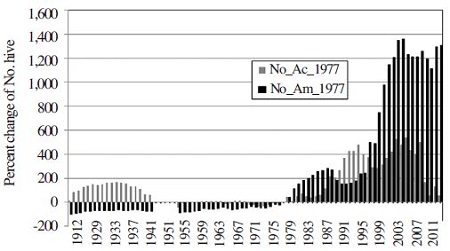
Fig. 2. Temporal trends of hive numbers of the native A. cerana and introduced A. mellifera in Korea (upper graph) and their relative proportion (lower graph) from 1912 to 2013.
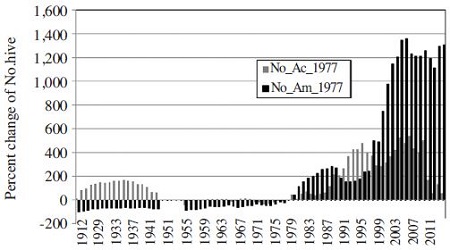
Fig. 3. Percent change of hive population of the native A. cerana and introduced A. mellifera based on the populations of 1977 in Korea. Four phases are distinct; 1912-1950, -1977, -2005, and 2005-2013.
However, dramatic increase of bee population occurred during the phase III. When compared to the 1997 populations, hive numbers of both species increased 4 times on A. cerana or 14 times on A. mellifera both with two modalities until 2005. Peak population of A. cerana was 370 thousand hives and that of A. mellifera was 1720, totaling over two million hives (Fig. 2).
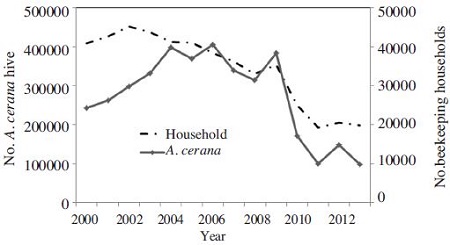
Recent change of the number of A. cerana hives and beekeeping householders after the epidemics of sac brood disease from 2009 in Korea.
In 1986, apicultural society of Korea was established to support the scientific discipline for apiculture. During 2000s for 10 years, hive populations were relatively stable and saturating. The phase IV began from 2005 when the number of beekeeping householders started to decrease and A. cerana population began precipitated from 2010 to 2013 continuously; beekeeping householders decreased into half (20,000s) and 25% of A. cerana population remaining. The pattern seemed similar to the colony collapse disorder syndrome from the West. However the primary factor would be the epidemics of sac brood virus of native honeybee, A. cerana. Since the beginning of the Korean sacbrood virus epidemics, 80-90% of native honeybee colonies died causing almost the extinction crisis (Choe et al., 2012; Kang et al., 2012). From the disappearance of any income sources for native honeybee keeping from the massacre of bees, native beekeepers left, and number of colonies dropped. In addition, there were some losses of A. mellifera not only from sac brood disease but also from various natural enemies such as vespid hornets (Villement et al., 2006; Rome et al., 2009; Kim et al., 2008; Jung et al., 2008; Jung, 2012).
Trend of Honey production and productivity
During phase I and until 1974, national honey production was lower than one thousand tons per year. In twenty years, honey production increased more than 10 times resulting 10 thousand tons in 1999. It doubled up in ten years reaching 20 thousand tons in 2001, and then honey production seemed stabilizing around 25 thousand tons per year with increasing variation recently (Fig. 5). Since the compositional proportion and density of each honeybee species showed distinct patterns of 4 phases, relationship between the numbers of honeybee hive and honey production was also analyzed separately and also pooled together by linear regression. In phase I, honey productivity was estimated as 4 kg/hive (Fig. 6. Reg. P<0.05, R2=0.7). There was no difference when applying explanatory variable of total hive number or hive number of A. cerana implying that overall honey production was attributed to native honeybee. During phase II, only significant trend was found with explanatory variable of A. mellifera hive number with productivity of 13.5kg/hive (Reg. P<0.05, R2=0.6). During these two phases, it was noted that as honeybee population increased, productivity increased showing more dots under the estimation line in lower population but over the line in higher population (Fig. 6, upper two graphs). From then, pooled data available from 1960 to 2013 were used for the analysis for phase III and IV. When using A. mellifera hive numbers as explanatory variables, productivity was estimated as 15kg/hive (R2=0.92), but 12.4 when using the total hive numbers including A. cerana (Reg. P<0.05, R2=0.93), indicating that the amount of explanatory power is minimal with addition of the A. cerana hive number. It seems logical that productivity of A. cerana would have not changed significantly from phase I since the beekeeping practices including the hive materials remained as it were (Jung, 2015). Also larger variation of the production with high honeybee population was shown in Fig. 6 (lower right part). This reflects the higher fluctuation of honey yield during 2010s. It is not certain that if the fluctuation leads damped stability or uncontrolled instability along with the climate change or other factors. Honeybees and beekeepers in Korea are highly depending on one floral source, black locust (Robinia pseudoaccaci). The dependency on honey production is about 70% (Jung and Ryui, 2007). Recent climate change brought some changes in beekeeping industry (Han et al., 2009). First, black locust flower blooms with the simultaneous blooming of acacia flower within a week or two from the southern to the northern part of South Korea. This make the beekeepers migration very difficult because one has to spend at least 7-10 days in one place where one has moved one’s bee colony for collect and harvest honey. In the past, it had taken about a month that acacia flowering from the south to the northern part. Second, degradation of the black locust trees in the mountain is the other problem. The black locust is a leguminous plant with the nitrogen fixing capability which can survive better in the bare, nutrient poor soil condition. Through the national campaign of the greening the country by transplanting and protection of the forest area, forest in Korea is now in the stable, semimature state where soil nutrients are conserved in the humus layer. Thus the natural succession of the vegetation is disfavoured for the black locust survival. Aged trees are dying back and also new pest infestation such as yellowing or leaf mining fly exacerbates the problem. Recent data from forest research institute provided the decrease of the black locust area was significant from 320,000 ha in 1990s to 80000 ha in 2009. Alternatives to the black locust tree are sought. Candidates are raisin tree, liriodendron tree, the bee tree and so on but now in slow plantation process which means that beekeepers and bees will suffer food shortage for a long time until those will completely replace the area. Also there are growing needs for pollination and pollination service for crop production and ecosystem service maintenance as well as protection from pesticides and others (Jung, 2008; RDA, 2010; Lee et al., 2014). Further factors such as honey plant biology, pest and disease pressure could influence the honey yield which can be studied.
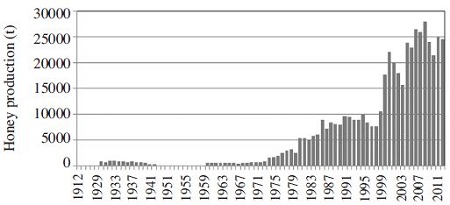
Temporal trend of honey production (ton) from 1912 to 2013 (Analyzed from the data from FAOstat, Korean beekeeping association and MAFF).
Acknowledgments
This publication was partly supported from RDA grant(PJ00997004).
LITERATURE CITED
- Choe, S.E., T.T.D. Nguyen, B.H. Hyun, J.H. Noh, H.S. Lee, C.H. Lee, and S.W. Kang, (2012), Genetic and phylogenetic analysis of South Korea sacbrood virus isolates from infected honey bees (Apis cerana), Veter-inary Microbiology, 157, p32-40, FAOstat, http://faostat.fao.org (2015.1.15access).
- Farrar, C.L., (1937), The influence of colony populations on honey production, J. Agri. Res, 54, p945-954.
- Han, J., M.S. Kang, S.H. Kim, K.Y. Lee, and E.S. Baik, (2009), Flowering, Honeybee visiting and nectar secretion characteristics of Robinia pseudoacacia L. in Suwon, Gyeonggi province, Korean J, Apic.24, p147-152.
- Jung, C., M.S. Kang, D. Kim, and H.S. Lee, (2007), Vespid wasps (Hymenoptera) occurring around apiaries in Andong, Korea, I. Taxonomy and life history, Korean J. Apic, 22, p53-62.
- Jung, C., D. Kim, H.S. Lee, and H. Baek, (2008), Some biological characteristics of a new honeybee pest, Vespa velutina nigrithorax Buysson, 1905 (Hymenoptera: Vespidae), Korean J. Apic, 23, p61-65.
- Jung, C., (2008), Economic evaluation of honeybee pollination on major fruit and vegetable crops in Korea, Korean J. Apic, 23, p147-152.
- Jung, C., (2012), Spatial expansion of an invasive hornet, Vespa velutina nigrithorax Buysson (Hymenoptera: Vespidae) in Korea, Korean J. Apic, 27, p87-93.
- Jung, C., (2014), A note on the early publication of beekeeping of Western honeybee, Apis mellifera, in : Korea, Yangbong Yoji (Abriss Bienenzucht) by, P. Canisius Kugelgen, Korean J. Apic, 29, p73-77.
- Jung, H.G., and J.B. Ryui, (2007), Korean nectar/pollen plants, Gyoungnam publisher, p294.
- Kang, S.W., M.S. Yoo, J.H. Noh, and H.S. Park, (2012), Occurrence and Prevalence of Honeybee Disease in Apis mellifera and Apis cerana in Korea, Korean J. Apic, 27, p187-195.
- KBA, (1983), Compendium of Korean beekeeping, Korean Beekeeping Association, Seoul, Korea.
- Kim, D., and C. Jung, (2007), Current status of beekeeping industry in Australia and Korea, Korean J. Apic, 22, p201-210.
- Kim, H.K., Y.S. Choi, M.L. Lee, M.Y. Lee, K.G. Lee, and N.H. Ahn, (2008), Detection of Sacbrood Virus (SBV) from the honeybee in Korea, Korean J. Apic, 23, p103-109.
- Kim, D.I., and R.H. Topel, (1995), Labor Markets and Economic Growth: Lessons from Koreaa TMs Industrialization, 1970-1990, In (ed) RB. Freeman, and LF. Katz, Differences and Changes in Wage Structures, Univer-sity of Chicago Press, p227-264.
- Lee, E.H., (2012), The Development of the Modern Korean Sugar Consumer Culture, Kor. History Res, 157, p191-223.
-
Lee, K.Y., S.G. Lee, Y.B. Lee, N.J. Kim, J.H. Kim, Y.S. Choi, P.D. Kang, and H.J. Yoon, (2014), Current status of honeybee production for pollination service in 2013, Korean J. Apic, 29, p245-256.
[https://doi.org/10.17519/apiculture.2014.11.29.4.245]

- Lee, M.Y., I.P. Hong, Y.S. Choi, N.S. Kim, H.K. Kim, K.G. Lee, M.L. Lee, (2010), Present status of Korean beekeeping industry, Korean J. Apic, 25, p137-144.
- Lew, Y.S., (1988a), Study of modern beekeeping in Korea, Korea Beekeeping Associaiton, Seoul Korea.
- Lew, Y.S., (1988b), A review on the efficacy of natural pollen described in an Oriental Medical Handbook “Dong-Eui-Pogam”, Korean J. Apic, 3, p26-47.
- Lew, Y.S., (1991), The study on beekeeping in the late Chosun dynasty, Korean J. Apic, 6, p106-140.
- RDA, (2010), Survey of pollinator insect use in tomato cultivation, RDA, p115.
- Rome, Q., F. Muller, O. Gargominy, and C. Villemant, (2009), Bilan 2008 de l’invasion de Vespa velutina Lepeletier en France (Hymenoptera: Vespidae), Bull. Soc. Entomol. Fr, 114, p297-302.
- SAS Institute, (2013), SAS/STAT user’s guide: statistics, version 9.4, SAS Institute, Cary, NC, USA.
- Villemant, C., J. Haxaire, and J.C. Streito, (2006), Premier bilan de l'invasion de Vespa velutina Lepeletier en France (Hymenoptera, Vespidae), Bull. Soc. Entomol. Fr, 111, p535-538.
